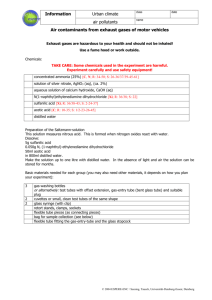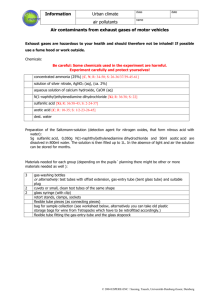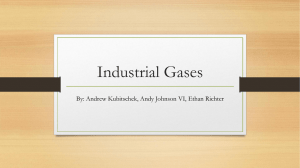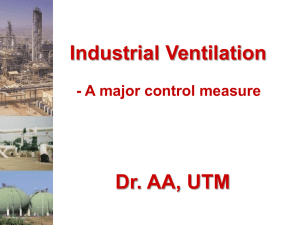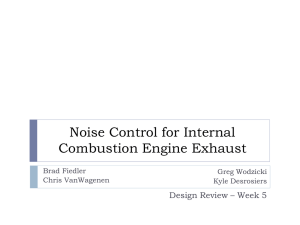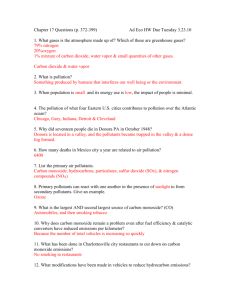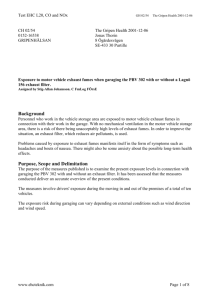Car exhaust experiment
advertisement
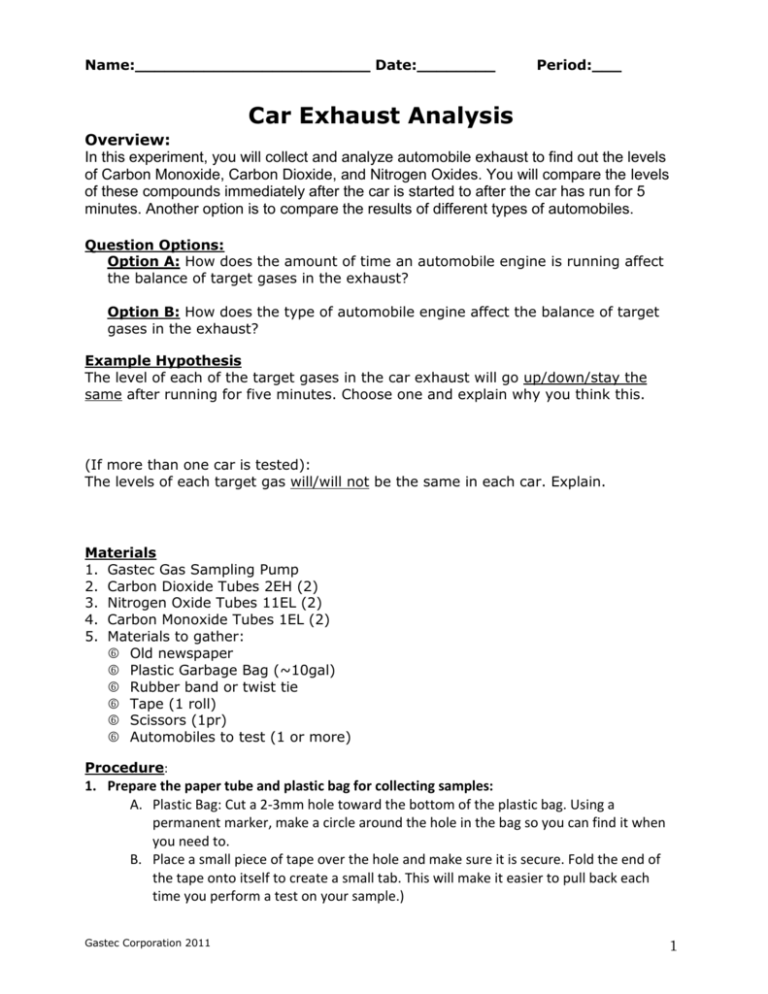
Name:________________________ Date:________ Period:___ Car Exhaust Analysis Overview: In this experiment, you will collect and analyze automobile exhaust to find out the levels of Carbon Monoxide, Carbon Dioxide, and Nitrogen Oxides. You will compare the levels of these compounds immediately after the car is started to after the car has run for 5 minutes. Another option is to compare the results of different types of automobiles. Question Options: Option A: How does the amount of time an automobile engine is running affect the balance of target gases in the exhaust? Option B: How does the type of automobile engine affect the balance of target gases in the exhaust? Example Hypothesis The level of each of the target gases in the car exhaust will go up/down/stay the same after running for five minutes. Choose one and explain why you think this. (If more than one car is tested): The levels of each target gas will/will not be the same in each car. Explain. Materials 1. Gastec Gas Sampling Pump 2. Carbon Dioxide Tubes 2EH (2) 3. Nitrogen Oxide Tubes 11EL (2) 4. Carbon Monoxide Tubes 1EL (2) 5. Materials to gather: Old newspaper Plastic Garbage Bag (~10gal) Rubber band or twist tie Tape (1 roll) Scissors (1pr) Automobiles to test (1 or more) Procedure: 1. Prepare the paper tube and plastic bag for collecting samples: A. Plastic Bag: Cut a 2-3mm hole toward the bottom of the plastic bag. Using a permanent marker, make a circle around the hole in the bag so you can find it when you need to. B. Place a small piece of tape over the hole and make sure it is secure. Fold the end of the tape onto itself to create a small tab. This will make it easier to pull back each time you perform a test on your sample.) Gastec Corporation 2011 1 2. Prepare the GV-50P BEFORE starting the car: A. Make sure the pump handle is pushed into the chamber. B. Break off the tip of both ends of the Carbon Dioxide Tube and place it in the yellow pump securely with the arrow pointing toward you. C. Place a red rubber tip protector at the end of the glass detector tube. 3. Collect Exhaust sample. (You will test each sample for collect for several gases.) A. Wrap the outside of the tailpipe with newspaper without blocking the exhaust. B. Compress the bag to remove all of the air from it and make sure the tape over the sampling hole is secure before collecting the sample. C. Hold the plastic bag against the newspaper that is wrapped around the tailpipe Collect exhaust sample: D. Have someone start up the car while another person is ready to collect the sample of exhaust and twist the bag closed once it fills with the car exhaust. (This happens very quickly so review steps before performing test.) E. Secure the rubber band or twist tie around the top of the bag so you are able to test the sample for three different gases: carbon monoxide, carbon dioxide and nitrogen oxide. 4. Test the sample: Carefully pull back the tape covering the sampling hole and insert the carbon dioxide tube tester into the bag and pull the pump handle until you hear a click. Wait for one minute, keeping the tube in the bag for at least one minute. 5. Collect the data: Write down in the data table listed below the number associated with the color change. 6. Repeat steps 1-5 for Carbon Monoxide and Nitrogen Oxides. Gastec Corporation 2011 2 Data Results: 1. Car Make/Model/Year:______________________ Time/Date:_____________ Type of Gas Detected CO2 (%) CO (ppm) NOx (ppm) Level Immediately after start-up Level 5 minutes after start-up 2. Car Make/Model/Year:___________________ Time/Date:_______________ Type of Gas Detected CO2 (%) CO (ppm) NOx (ppm) Level Immediately after start-up Level 5 minutes after start-up 3. Car Make/Model/Year:___________________ Time/Date:_______________ Type of Gas Detected CO2 (%) CO (ppm) NOx (ppm) Level Immediately after start-up Level 5 minutes after start-up Analyzing Data 1. Which of the target gases was highest at start-up? Was this the same for all vehicles? Describe. 2. Which of targeted gas levels was highest in the car exhaust after running for five minutes? 3. Which of targeted gas levels showed the greatest amount of change after running for five minutes? 4. Construct a data table and graph(s) showing the change over time of the level of each targeted gas and/or graphs comparing the different cars’ exhaust components. (Attach) Gastec Corporation 2011 3 Discussion of Results 1. Restate your hypothesis beginning with the statement, “The experimental data supported---or, did not support---my hypothesis, 2. Explain how the data supports, or does not support, your hypothesis referring to the specific measurements, calculations, or patterns you noticed. 3. How can the experimental design be improved to improve the data? 4. Why did these results occur? What is the significance of them? Identify any scientific, or social or technological concerns or opportunities that could be addressed. Recommend possible solutions. 5. What questions would you ask to extend this experiment? Gastec Corporation 2011 4 Background on Car Exhaust There are more than 600 million cars driving roads all over the world. While pollution reduction laws have reduced harmful emissions over the past 20 years, the numbers of cars and trucks on the road and the miles they are driven have doubled in the same period. Vehicles are now driven two trillion miles each year in the United States.1. The exhaust system of an automobile is designed to carry away the gases created when the fuel and oxygen in the air are burned in the combustion chamber of the engine. The exhaust from a combustion engine consists mostly of water vapor (H2O), and carbon dioxide (CO2). Some exhaust contains toxic gases such as carbon monoxide (CO), nitrogen oxides (NOx), Ozone (O3), and particulate matter in high enough concentrations to contribute to respiratory problems in humans and wreak havoc in Earth’s fragile atmospheric envelope of gasses of which most life depends. Carbon monoxide is a colorless and odorless asphyxiant that combines with the hemoglobin in the bloodstream causing a decrease the amount of oxygen delivered to the tissues. This can lead to dizziness, loss of consciousness and in some cases—death. In the United States, 75% of CO emissions come from motor vehicles such as cars, trucks, boats, and construction equipment. The current Occupational Safety and Health Administration (OSHA) permissible exposure limit for carbon monoxide is 50 parts per million (ppm).2 Approximately half of the NOx released in car exhaust is released in the initial minutes after start up, when the catalytic converter is not in full operation. Nitrogen oxides are created when the heat in the engine forces nitrogen in the air to combine with oxygen. This NO x plays a significant role in the formation of acid rain and it plays a key role in upper atmosphere and in ground-level ozone formation. Reducing the NOx released in the initial start-up of the car could successfully cut the environmental burden by as much as 25 percent.3 In a study of the effects of car exhaust on children, researchers discovered that a high rate of road traffic was correlated to increased respiratory symptoms in children.4 Policies and regulations that require automobile manufacturers to reduce harmful emissions have led to innovations like Catalytic Converters (most cars have been equipped since the mid-70’s.) In chemistry, a catalyst is a substance that causes or accelerates a chemical reaction without itself being affected. Catalysts participate in the reactions, but are neither reactants nor products of the reaction they catalyze. In the human body, enzymes are naturally occurring catalysts responsible for many essential biochemical reactions. In your car, the Catalytic Converter strips the Oxygen molecule from the NOx and holds onto the nitrogen and releases the O2. Then it oxidizes the carbon monoxide and turns it into carbon DIOXIDE.5 _______________________________________ 1. Environmental Protection Agency, Carbon Monoxide: Chief Causes for Concern, http://www.epa.gov/air/urbanair/co/chf1.html 2 US Dept of Labor, Occupational Health and Safety Guideline for Carbon Monoxide (Retrieved Feb 20011) http://www.osha.gov/SLTC/healthguidelines/carbonmonoxide/recognition.html 3 Clean school bus initiative through EPA. (Retrieved Feb 2011) http://www.epa.gov/otaq/schoolbus/index.htm 4 Wjst., M. et. al., (1993) Road traffic and adverse effects on respiratory health in children. http://www.bmj.com/content/307/6904/596.abstract 5. Nice, Karim, Bryan, Charles, How Stuff Works, How Catalytic Converters Work, (Retrieved Feb 2011) http://auto.howstuffworks.com/catalytic-converter2.htm Gastec Corporation 2011 5 Teacher Information Car Exhaust Purpose: In this experiment, students will collect and analyze automobile exhaust to find out the levels of Carbon Monoxide, Carbon Dioxide, and Nitrogen Oxides. They will compare the levels of these compounds immediately after the car is started to after the car has run for 5 minutes. Students can also test and compare the results of different types of automobiles. Introduction of Experiment: ~ 20 minutes Experimentation: ~ 30-40 minutes Clean up: ~ 10 minutes Background Reading & Lab Report: ~60 minutes (Homework) Curricular Connection National Standards Science in Personal and Social Perspectives: Evaluate the impact of human activities on environmental quality and the sustainability of Earth Systems. Describe how environmental factors influence resource management. Interaction and Change: the components in a system can interact in dynamic ways that may result in change. In systems, changes occur with a flow of energy and/or transfer of matter. Scientific Inquiry: the investigation of the world by a systematic process that includes proposing a testable question and hypothesis, developing procedures for collecting, analyzing, and interpreting accurate and relevant data to develop evidence-based explanations and ask new more advanced questions. Tips for Successful Experimentation: Assign Background reading prior to doing the lab If you are testing more than one car, it is good to have them all parked close so you can work with all the groups more easily. The experimental procedure can be tricky making it an assessment opportunity. The sampling bag should be emptied of all air. WARNING: the tailpipe can be very hot after the car has been running for five minutes. It is good to use extreme caution when collecting the sample to prevent from touching the tailpipe with bare hands or breathing the fumes from the automobile. Sample Results: Car #1 – 1984 Toyota Landcruiser Type of Gas CO2 (%) CO (ppm) NOx (ppm) Gastec Corporation 2011 Car #2 - 2007 Toyota Yaris Car #3- 2004 Toyota Matrix Immediate 5 min Immediate 5 min Immediate 5 min 6 400 20 8 400 20 2 400 20 8 0 10 6 400 20 8 0 12 6 Analyzing Data: 1. Which target gases were highest at start up? Carbon monoxide was at the highest level in all three cars. 2. Which target gas increased after 5 minutes in all three cars? Carbon Dioxide 3. Construct a graph showing the levels of the targeted gases in each vehicle tested. Gastec Corporation 2011 7 Assessment(s): 1. Observe and note students’ ability to execute a lab procedure properly and collaborate with classmates. 2. Observe and note students’ ability to participate in a discussion of results. 3. Have students write a Lab report. Extensions: 1. Test and compare exhaust from different types of engines: diesel, hybrid 2. Test and compare exhaust from different types of fuels. 3. Test levels and multiple and shorter intervals, e.g. every two minutes for ten minutes. Gastec Corporation 2011 8
